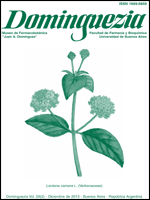Anatomical studies of Baccharis grisebachii Hieron. (Asteraceae). Used in folk medicine of San Juan province, Argentina
Palabras clave:
quilchamali, anatomical studies, epidermis, leaf, stem, root, estudios anatómicos, hoja, tallo, raízResumen
Baccharis grisebachii Hieron., commonly known as "quilchamali", is a bushy plant that lives in the high mountains of Argentina and southern Bolivia. The infusion or decoction of aerial parts is used in the traditional medicine of San Juan province, Argentina, to treat gastric ulcers, digestive problems, and as antiseptic and wound healing in humans and horses. The aim of this study is to analyze the anatomical characters of B. grisebachii for specific identification and quality control. The results show that the leaf blade is ericoid with a dorsiventral mesophyll, and epidermis has a smooth and thick cuticle. The stomata are anomocytic. In both epidermis there are two types of hairs, not glandular and glandular. Adult stems show secondary structures. The root shows 1 - 2 rows of pericyclic cells and an endodermis. B. grisebachii shows xeromorphic anatomic characters. The structural characters provide micrographic reference standards, useful for quality control at the crude drug stage.Descargas
Número
Sección
Artículos
Cómo citar
Anatomical studies of Baccharis grisebachii Hieron. (Asteraceae). Used in folk medicine of San Juan province, Argentina. Dominguezia, 29(2), 41-47. http://ojs.dominguezia.org/index.php/Dominguezia/article/view/2013%2029%282%29-5


